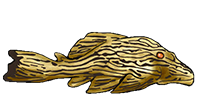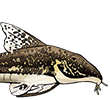| Scientific Name | Ancistrus cryptophthalmus Reis, 1987 |
| Common Name | Bristlenose Catfish |
| Type Locality | Caverna Passa Três, about 300 meters into the cave, 13°20' to 13°52'S, 46°16' to 46°30'W, Rio São Vicente system, São Domingos, Goiás State, Brazil. |
| Pronunciation | an SISS truss - krip toff thal muss |
| Etymology | The name Ancistrus is derived from the Greek word agkistron, meaning hook, in reference to the interopercular odontodes that are hooked. This specific epithet literally means hidden (kryptos=hidden) eyes(opthalmus=eyes) and refers to the cave species lack of eyes. |
| Size | 60mm or 2.4" SL. Find near, nearer or same sized spp. |
| Identification | Mature males and sometimes females have soft tentacles (bushy fleshy growths) on the snout - this is unique to the genus Ancistrus. A blind species; living all its life in the darkness of the cave, it has lost the need for eyes and does not have any. It still has a slight medium sized spotted pattern around the head. |
| Sexing | Typical for the genus with males possessing the so-called ''bushy nose''. Females also may have much smaller growths on the head but to a much lesser extent. |
| General Remarks | The type locality was reported within a range of latitudes and longitudes. Here the ranges have been averaged as 13°36'S, 46°23'W in order to pin the type locality. |
| Distribution | South America: São Vicente and Angélica-Bezerra cave system in upper Paraná River, Tocantins River drainage in Brazil. Login to view the map. |
| IUCN Red List Category | Endangered , range map and more is available on the IUCN species page. Last assessed 2018. |
| Feeding | Ancistrus should be fed mainly on vegetarian foods. Prepared foods include algae wafers and spirulina based sinking food. Vegetables such as courgette/zucchini, and (English) cucumber are an excellent addition to the diet, along with the odd, small amount of more meaty foods. User data. |
| Compatibility | A good complement to most aquariums, they are not aggressive to other species. Males may fight over territory if kept in too small a tank. |
| Suggested Tankmates | Appropriate with most community fish that aren't overly big or aggressive. |
| Breeding | Has been bred. Tank of 100 litre, 17-25°C depending on season, with negligible daily variation, decorated with limestone. Tank was in darkness except for maintenance activities. Breeding and fry care is as for other Ancistrus species. |
| Breeding Reports | There is no breeding report. |
| Reference | Revue française d'Aquariologie Herpétologie v. 14 (no. 3), pp 82, Figs. 1, 3-4. |
| Registered Keepers | There is no registered keeper. |
| Wishlists | Love this species? Click the heart to add it to your wish list. There is no wish to keep this species. |
| Spotters | Spotted this species somewhere? Click the binoculars! There is no record of this fish being seen. |
| Forum BBCode | |
| Search for A. cryptophthalmus | |
| Look up A. cryptophthalmus on AquaticRepublic.com | |
 | Look up A. cryptophthalmus on Fishbase |
 | Look up A. cryptophthalmus on Encyclopedia of Life |
 | Look up A. cryptophthalmus on Global Biodiversity Information Facility |
| LFS label creator ARN ref:1.4.4.1139 | |
| Last Update | 2025 Jan 01 12:06 (species record created: 2003 Nov 09 00:00) |





/siluriformes/loricariidae/ancistrus/cryptophthalmus/1.jpg)
/siluriformes/loricariidae/ancistrus/cryptophthalmus/2.jpg)
/siluriformes/loricariidae/ancistrus/cryptophthalmus/3.jpg)
/siluriformes/loricariidae/ancistrus/cryptophthalmus/4.jpg)